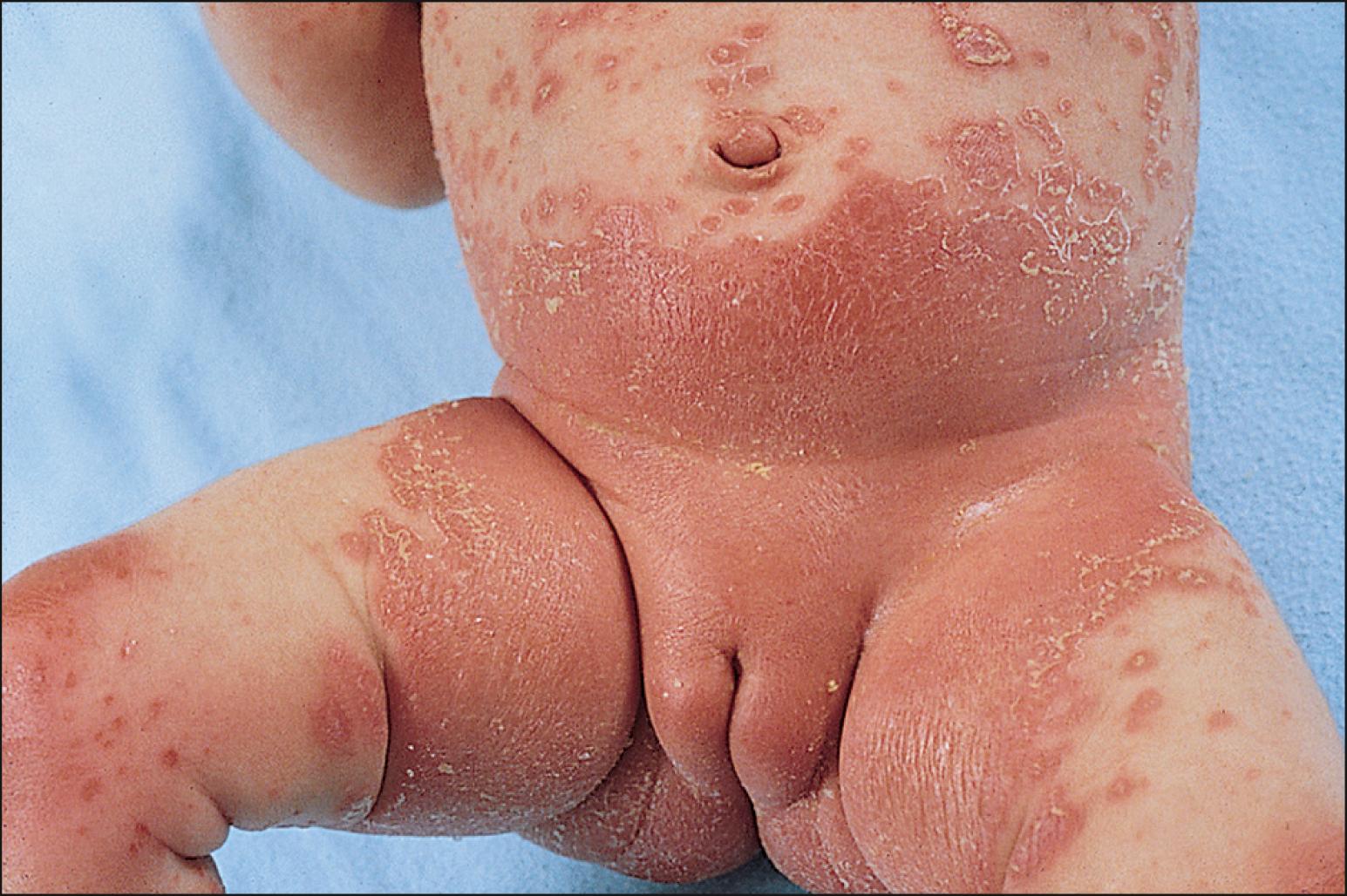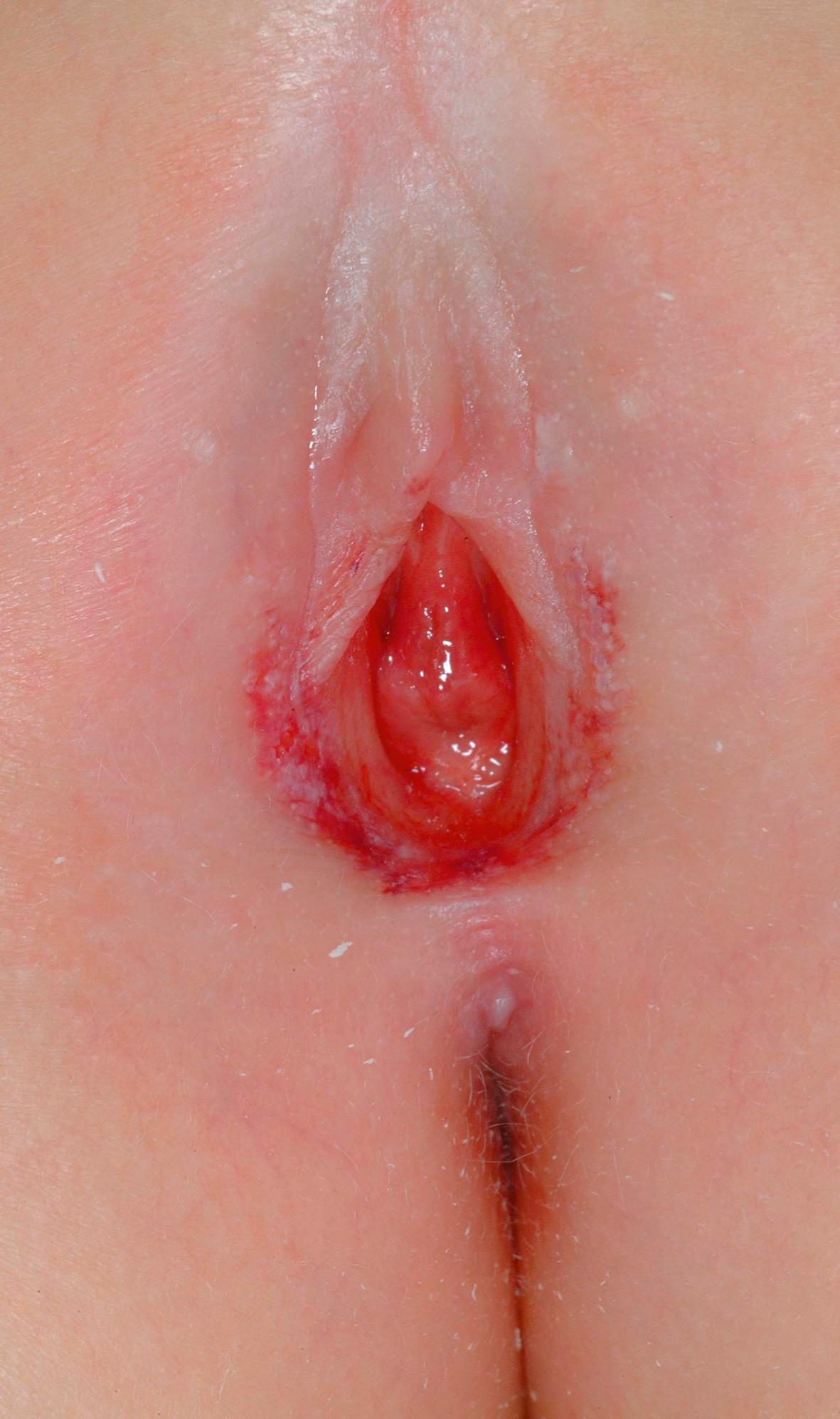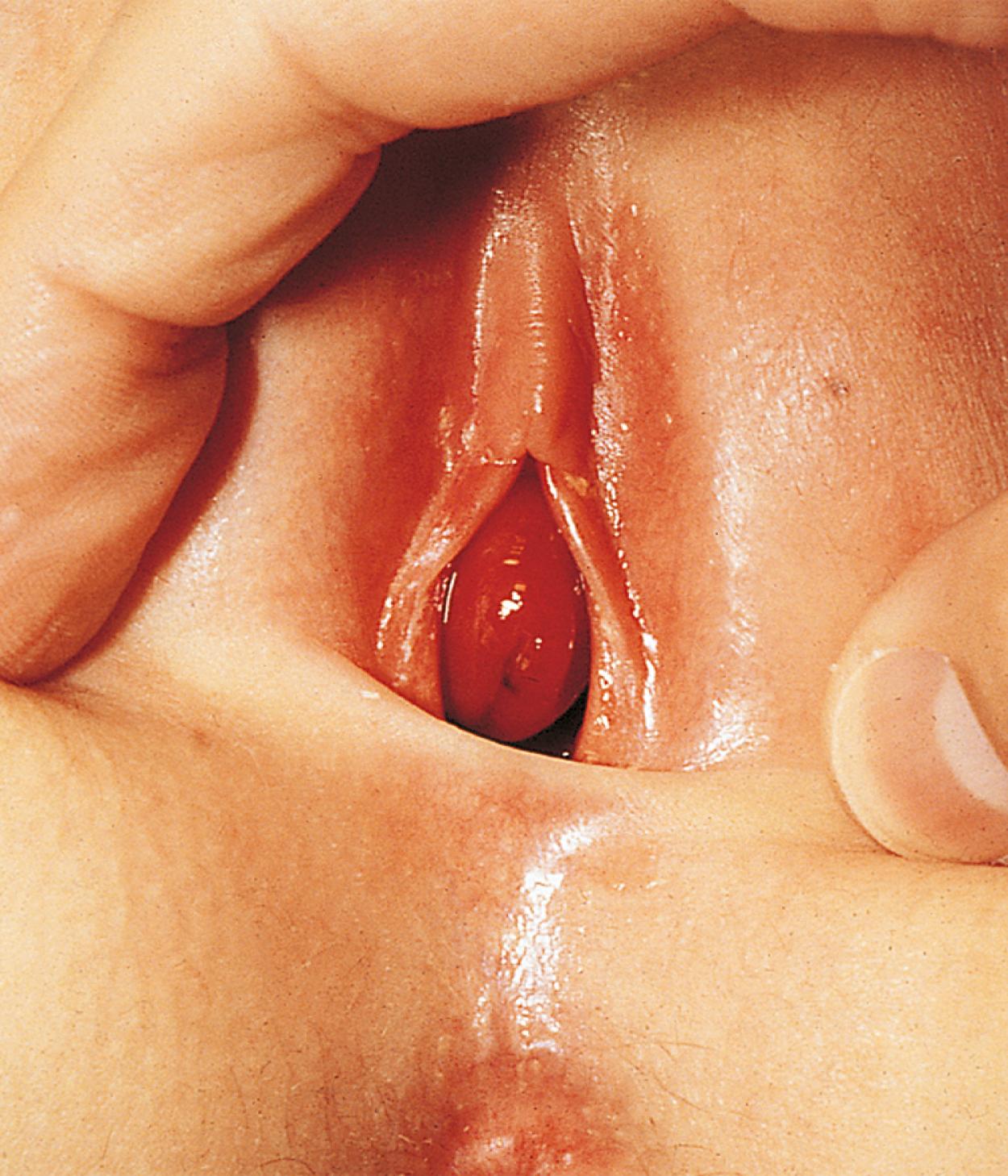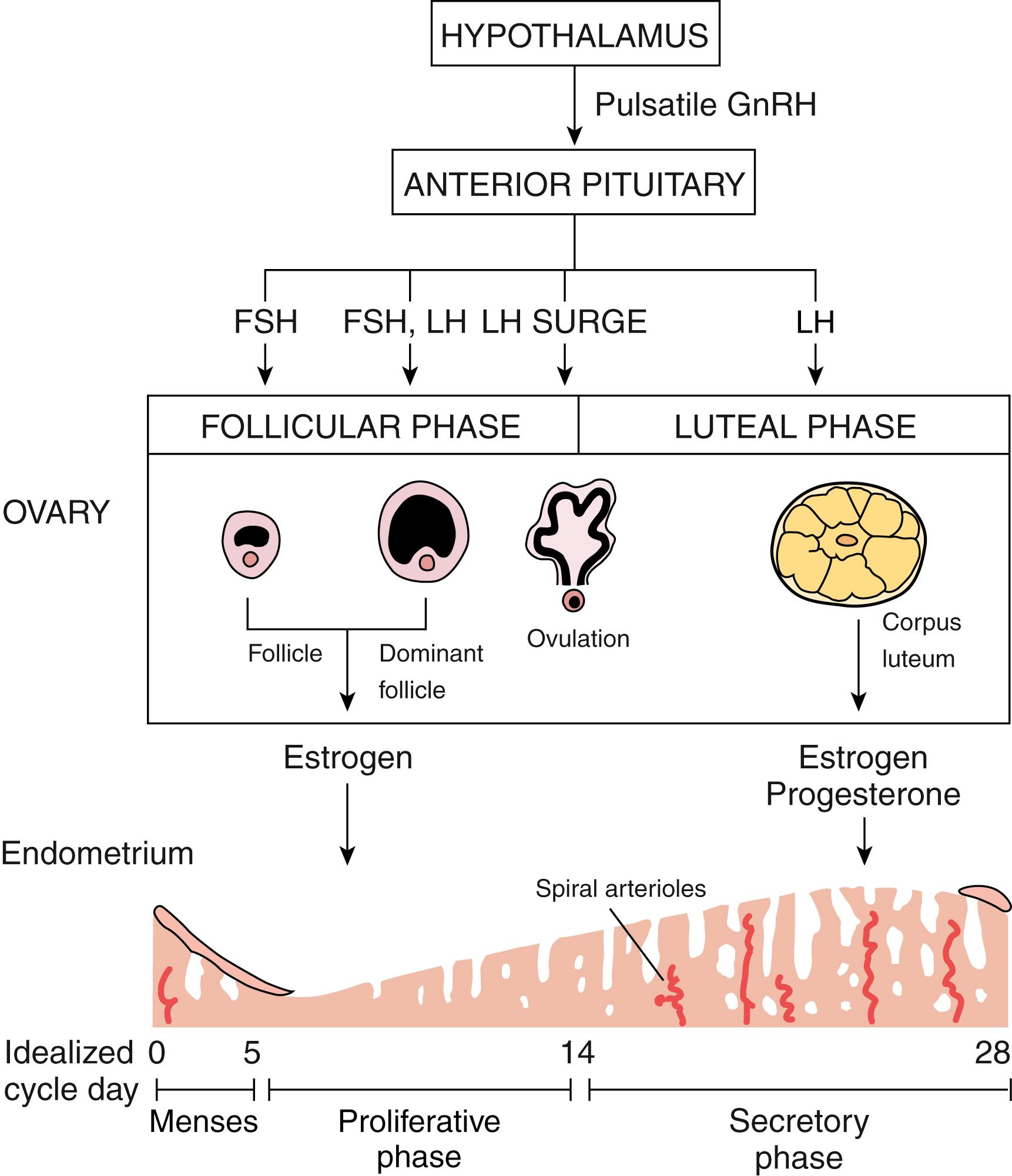Physical Address
304 North Cardinal St.
Dorchester Center, MA 02124
The source of abnormal vaginal bleeding during prepubertal childhood is much more likely to be the vulva or vagina rather than the uterus. There are unique characteristics making history and physical examination effective in narrowing the diagnostic possibilities as seen in Table 25.1 . Collecting information regarding recent trauma, medication exposure, rashes or irritation of the external genitalia, abdominal pain, chronic cough, constipation, and malodorous discharge is essential in making a diagnosis efficiently. A sensitive assessment regarding the possibility of sexual assault should be made, and an age-appropriate physical examination should be conducted noting the presence or absence of other pubertal signs, abnormalities of the vulva or urethra, vaginal discharge, and abdominal or vaginal masses.
| Pain or Irritation | Associated Characteristics | Family History | |
|---|---|---|---|
| Estrogen withdrawal | No | First week of life (neonates) | No |
| Foreign body | No | Malodorous | No |
| Vaginal infection | Yes | Recent upper respiratory infection | No |
| Vulvar dermatoses | Yes | Vulvar discoloration or lesion Extragenital skin findings |
Yes |
| Urethral prolapse | No | Chronic cough or constipation Red, beefy, protuberant urethra |
No |
| Straddle injury | Yes | Provoking injury Visible laceration |
No |
| Precocious puberty ∗ | No | Cyclic pattern of bleeding Secondary sexual characteristics present |
Yes |
| Vaginal malignancy | Possible | Visible mass | No |
| Isolated functional ovarian cysts | No | None | No |
∗ McCune-Albright syndrome, central precocious puberty, juvenile granulosa cell tumor, severe hypothyroidism.
Vaginal bleeding presenting within the first several days of life is most commonly due to estrogen withdrawal. Maternal estrogen enters fetal circulation stimulating proliferation of the endometrium. External genitalia examination typically reveals estrogenization, with thickened vulvar mucosa and leukorrhea. Several days after delivery, serum estrogen levels fall significantly, leading to a reduction of blood supply to the endometrium, and the lining sheds as ischemia develops. If vaginal bleeding occurs within the first few days of life with a normal physical examination, a work-up is not needed provided the bleeding spontaneously resolves.
The presence of a vaginal foreign body is another common cause of vaginal bleeding in early childhood. This bleeding is often described as persistent, light in quantity, brown colored, and malodorous. The physical examination is unremarkable other than the possible presence of a vaginal malodor. The most common foreign body found in the vagina is toilet paper, although many other solid objects have been reported. Depending on the age and cooperation of the patient, lateral and downward traction of the labia majora may allow direct visualization of the foreign body. Toilet paper can be retrieved in the office by gently irrigating the vagina with water using a small, flexible pediatric feeding tube. In cases where an optimal pelvic examination is not possible, a vaginoscopy under sedation should be performed. One technique is to place an 8 French Foley catheter in the vagina. A 5-mm laparoscope is simultaneously placed in the vagina. Saline is then flushed into the vagina using the Foley catheter while the labia majora are manually held together. The vagina is then distended allowing for complete visualization of the vaginal cavity including the cervix and any foreign body present. Simply removing the foreign body will adequately treat the symptoms; no antibiotic therapy is needed. A vaginal foreign body should not automatically trigger a full sexual assault evaluation; this investigation should be conducted if there is indication by history, or if suspicious scarring of the posterior fourchette is noted.
Prepubertal vaginal infection may present with bleeding and discharge. Unlike vaginal foreign body, the bleeding is typically red in color and not malodorous. Vaginal infection is also associated with complaints of external genital irritation. Mucosal erythema on physical examination is notable, particularly when the pathogen is group A β-hemolytic streptococcus. The diagnosis is confirmed with culture of the vaginal canal. A specimen for culture can be collected using the gentle irrigation technique described previously if vaginal swab placement is not possible. In addition to group A β-hemolytic streptococcus, other pathogens that are commonly identified include Haemophilus influenzae , Escherichia coli , Shigella , and Salmonella species, with the latter two being particularly associated with vaginal bleeding. A recent history of an upper respiratory infection should raise suspicion of this diagnosis as the majority of vaginal infections arise from autoinoculation. Notably, Candida infections of the vagina are uncommon in this population.
Vulvar dermatoses can also present with vaginal bleeding and significant irritation or pain of the external genitalia. In this case, the bleeding is minimal, often caused by trauma from scratching. While vulvar dermatosis in the prepubertal population is relatively uncommon, atopic dermatitis , lichen sclerosus , and psoriasis are the most commonly described conditions ( Figs. 25.1 and 25.2 ). Atopic dermatitis will only occur in regions in contact with the allergen. Suspicion for the latter two conditions should be raised if extragenital skin findings are noted, or if a positive family history is elicited. The typical appearance of lichen sclerosus is white parchment paper–like appearance in an hourglass distribution. Obliteration of the labia minora and clitoris can occur with long-standing disease. Pinpoint bruising can also occur. While this is not the most common presentation, it is worth noting as it can be concerning for trauma. The treatment involves short courses of high-potency topical steroids and usually resolves as serum estrogen levels rise with maturation. Psoriasis typically appears as an erythematous plaque or papule marked by fissures, erosions, or scales. Treatment includes topical steroids, fluorinated ointments, emollients, and newer immunomodulators. In both cases, biopsy is needed to confirm the diagnosis; however, if clinical suspicion is high and symptoms are severe, empiric treatment prior to biopsy is reasonable. Other vulvar lesions that can produce bleeding include hemangiomas and genital warts.


Urethral prolapse is another cause of prepubertal vaginal bleeding associated with a classic physical examination finding ( Fig. 25.3 ). It is seen more commonly in young females. The only complaint is bleeding; there is no coexisting pain or irritation. The limited estrogen levels in childhood leave the urethra vulnerable to prolapse, especially in the setting of frequent Valsalva maneuvers from chronic cough or constipation. On physical examination, the urethra appears prominent, erythematous, and tubular “doughnut shaped,” protruding well beyond the urethral meatus. Topical estrogen therapy for 1–2 weeks is typically effective in resolving this condition. Rarely, urethral necrosis or urinary retention can occur. In these cases, topical estradiol therapy may still be effective, but surgical resection may be needed for treatment.

While the vast majority of lesions of the external genitalia causing prepubertal bleeding are benign, malignancy has been reported. Sarcoma botryoides , a variant of rhabdomyosarcoma, is the most common vaginal tumor in childhood. The classic description of this tumor is a protruding vaginal mass with grapelike vesicles. Other malignant tumors of the lower genital tract that have been reported include mesenchymal tumors, neural ectodermal tumors in the Ewing family, and mixed müllerian tumors. Any abnormal-appearing vaginal mass should raise concern for malignancy and should prompt a referral to an appropriate specialist for evaluation.
Bleeding secondary to a perineal injury presents acutely with pain and is associated with a clear provoking event unlike the other causes of childhood vaginal bleeding. Straddle injuries are the most common childhood injury to the genitalia and can lead to a bleeding laceration. This injury is caused by a nonpenetrating blunt force to the perineum when the legs are apart. Classic activities associated with straddle injuries include bike riding, playing on a seesaw, and gymnastics. Water-jet injuries related to falls during water sports can also be a mechanism for vaginal laceration and hemorrhage. An examination must be done to determine whether the laceration requires primary closure with suture. Conscious sedation or examination under anesthesia is appropriate for straddle injury evaluations as pain may prohibit a thorough evaluation. If the history does not substantiate the injury, a sensitive interview should be conducted prior to the examination. Co-examination with the sexual assault team is important should there be any suspicion.
Prepubertal vaginal bleeding presenting with breast development and growth acceleration should raise concern for precocious puberty (see Chapter 55 ). Conventional thinking defines pubertal changes before age 8 years as precocious. However, this is debated as hallmarks of puberty have been appearing earlier over the past century and differ by race in the United States. Important historical cues that are helpful in making a diagnosis include symptoms or known central nervous system (CNS) abnormalities, symptoms of hypothyroidism, family history of early puberty, Peutz-Jeghers or McCune-Albright syndrome, or neurofibromatosis type 1. Height, Tanner staging of the breasts and pubic hair, and external genital changes consistent with estrogen exposure, such as elongation of the labia minora and thickening of vulvar mucosa, should be specifically evaluated during physical examination. Café-au-lait spots, presence of an abdominal mass, and thyroid gland abnormalities should also be assessed. Radiographic imaging to determine the bone age of the left wrist can identify elevated serum estrogen levels and is a good initial screening test. Laboratory evaluation confirming precocious puberty includes elevated serum estradiol, androgen panel, and gonadotropins. Imaging may also be needed in some clinical scenarios.
Early elevated serum estrogen most commonly occurs because of maturation of the hypothalamic-pituitary-ovarian (HPO) axis, termed gonadotropin-releasing hormone (GnRH)–dependent precocious puberty. In this condition, the pathology is simply the early timing of maturation. Administration of a GnRH analog is effective in temporarily stopping anterior pituitary production of gonadotropins, ultimately preventing sex hormone production from the ovary. The purpose of halting early puberty is to avoid age-inappropriate social contact, and to preserve height, which is particularly effective when treating patients 6 years of age or younger. Rarely, GnRH pulsatile release is stimulated by CNS abnormalities such as infection, tumors, hydrocephaly, meningomyelocele, neonatal encephalopathy, or cranial radiation. Type 1 neurofibromatosis and tuberous sclerosis are also associated with GnRH-dependent precocious puberty. Imaging of the CNS should be aggressively pursued if there is suspicion of a CNS lesion, if pubertal progression is rapid, or if the child is under age 6.
GnRH-independent precocious puberty is a much less common cause of precious puberty. In this condition, the hypothalamus is not driving ovarian sex steroid hormone production. Conditions such as malignant granulosa cell tumors of the ovary, benign functional ovarian cysts, or tumors of the pituitary or adrenal gland are responsible for the elevated serum estrogens. McCune-Albright syndrome, Peutz-Jeghers syndrome, and hypothyroidism are associated with GnRH-independent precocious puberty as well.
GnRH-dependent and -independent precocious puberty are associated with different history and physical examination cues ( Table 25.2 ). A GnRH stimulation test is effective in differentiating these two processes. A rise in gonadotropins after exogenous administration of GnRH suggests that the HPO axis is active, confirming GnRH-dependent precocious puberty.
| GnRH-Dependent Precocious Puberty | GnRH-Independent Precocious Puberty | |
|---|---|---|
| Prevalence | More common | Less common |
| Family history of early puberty | Positive | Negative |
| Unique characteristics | History or symptoms of CNS lesions, tumors, or infections | Symptoms of hypothyroidism, café-au-lait lesions, known Peutz-Jeghers syndrome |
| GnRH stimulation test | Positive | Negative |
Establishment of the menstrual cycle is a major hallmark of adolescence. The menstrual cycle serves as a marker of health, so much so that it has been heralded as a “vital sign” during adolescence. Irregular menstrual bleeding may simply be related to the maturation of the complex physiologic process leading to puberty. In other cases, irregular menstrual bleeding may be a symptom of a significant medical condition ( Table 25.3 ). A basic understanding of the menstrual cycle is helpful when trying to understand the many causes of abnormal bleeding.
| Cycle Length | Intermenstrual Bleeding | Heavy Menses | Unique Characteristics | Family History | |
|---|---|---|---|---|---|
| Coagulopathy | Prolonged | No | Yes | Bruising Epistaxis Gingival bleeding |
Yes |
| HPO axis immaturity | Variable | No | Variable | None | No |
| PCOS | Variable | No | Variable | Acne Hirsutism Central obesity |
Yes |
| Endometrial causes | Prolonged | Yes | No | Unprotected sexual activity Vaginal discharge Fever Cervical motion tenderness Uterine tenderness |
No |
| Contraceptive breakthrough | Prolonged | Yes | No | Progesterone-only contraceptive use Improper use of hormonal contraception |
No |
| Adenomyosis | Prolonged | No | Yes | Symmetrically enlarged uterus | Possible |
| Leiomyoma | Prolonged | No | Yes | Asymmetrically enlarged uterus | Yes |
| Polyp | Prolonged | Yes | No | None | No |
Complex interaction between the hypothalamus, pituitary, ovary, and uterus leads to ovulatory menstrual cycles ( Fig. 25.4 ). The hypothalamus releases pulses of GnRH into a portal system to the pituitary gland. The anterior pituitary is stimulated to release the gonadotropins, follicle-stimulating hormone (FSH) and luteinizing hormone (LH), when exposed to GnRH pulses. LH acts on the theca cells of the ovary leading to androgen production; these hormones are aromatized to estrogens in the granulosa cells of the ovary under the influence of FSH. This drives development of the dominant follicle.

Interaction between the anterior pituitary and ovary is complex in that it is bidirectional. Gonadotropin release is stimulated by GnRH and modulated by ovarian hormones, both the sex steroid hormones and the peptide hormones, activin and inhibin. In the first half of the cycle, the dominant follicle grows in size leading to increased estradiol production. A positive feedback relationship is seen between the ovary and the anterior pituitary, with higher levels of estradiol stimulating gonadotropin release. This ultimately leads to the LH surge, triggering ovulation.
Postovulation, the dominant follicle transforms into a progesterone-secreting corpus luteum. During this phase of the cycle, estradiol inhibits gonadotropin release, preventing the development of another dominant follicle. The corpus luteum sustains progesterone secretion for 14 days; beyond this point, continued progesterone secretion is dependent on β-human chorionic gonadotropin (β-hCG) signaling from a pregnancy. If no pregnancy occurs, the corpus luteum regresses, and progesterone levels drop.
The endometrium is a mucosal surface lining the uterine cavity. Its thickness and composition are under the influence of estradiol and progesterone. During the preovulatory estradiol-dominant phase, termed the proliferative phase, the endometrium rapidly grows. The endometrial lining undergoes glandular differentiation to optimize implantation during the postovulatory progesterone-dominant phase, termed the secretory phase . If no pregnancy occurs, the spiral arterioles supplying the endometrium undergo spasm secondary to waning estradiol and progesterone levels. The endometrium becomes ischemic and sheds, producing menstrual bleeding. The amount of menstrual blood directly correlates with the thickness of the endometrium, the activity of the coagulation cascade directing the clotting of the vessels, and the re-exposure to estrogen with the start of the new cycle. Any abnormality in these processes can lead to an abnormal bleeding pattern.
Normal parameters of the menstrual cycle should be understood to correctly identify abnormal patterns of bleeding. The cycle interval describes the number of days between the first day of one period and the first day of the next period. A normal cycle interval in adolescents is between 21 and 45 days. The cycle length describes the number of days menstrual bleeding lasts. A normal cycle length is conventionally described as less than 7 days. The amount of bleeding is much harder to quantify. Greater than 80 mL of menstrual blood loss during a cycle is considered pathologically heavy, with the average blood loss being 30 mL. The clinical impracticality of obtaining this information is obvious. Menstrual blood flow requiring soaked pad changes every 1–2 hours is conventionally considered to be pathologically heavy.
Information regarding the start of menarche, cycle interval, cycle length, bleeding between menses, and questions detailing the quantity of blood flow is essential in the assessment of abnormal bleeding. The acronym PALM-COEIN has been devised to categorize the multiple causes of abnormal uterine bleeding ( Table 25.4 ). The conditions falling under the PALM group describe structural abnormalities and are much less common in the adolescent population than the nonstructural conditions falling under the COEIN group.
| Palm | Coien |
|---|---|
| Polyp Adenomyosis Leiomyoma Malignancy |
Coagulopathy Ovulation dysfunction Iatrogenic causes Endometrial causes Not otherwise specified |
Pregnancy evaluation is an important early step in the assessment of abnormal bleeding in the adolescent. Bleeding in pregnancy, particularly in the first trimester, is common and can occur with a normal or an abnormal intrauterine pregnancy or an ectopic pregnancy. Pregnancy-associated bleeding can be light or heavy; similarly, it may be painless or associated with uterine cramping. A thorough history is helpful in understanding the heaviness of the current bleeding episode, determining the date of the last normal menstrual cycle, and assessing sexual and contraceptive activity. Physical examination can be helpful if the patient is beyond the first trimester as the uterus may be palpable on abdominal examination. A pelvic examination to assess the size of the uterus is helpful in the first trimester but may not be appropriate for all adolescent patients. If a pregnancy is diagnosed by urine β-hCG testing, the viability of the pregnancy may be determined with ultrasound or serial β-hCG measurements 48 hours apart early in pregnancy. The threshold minimum rise expected depends on the starting β-hCG level: at least 33% if the level is >3,000 mIU/mL to 49% if the level is <1,500 mIU/mL. Dropping or plateauing levels in early pregnancy are typically diagnostic of an abnormal intrauterine or ectopic pregnancy. Early assessment is essential due to the morbidity associated with a delayed diagnosis of an abnormal pregnancy.
Become a Clinical Tree membership for Full access and enjoy Unlimited articles
If you are a member. Log in here